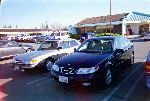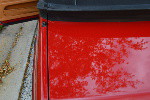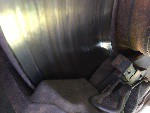
1994-2002 [Subscribe to Daily Digest] |
Why is roll stiffness different in the front and rear?
For a second let us assume that we have an infinitely stiff chassis. Next let us have a solid axle in the front that has no suspension (infinitely stiff in roll and ride) All tires are also infintetly stiff for now. In the rear we have an independent suspension that only has roll stiffness due to the main springs.
Now we attach a long lever on the top of the car and apply a rolling moment to it. Since the front suspension cannot allow any deflection, it can not roll. The rear could allow deflection, but since the front is preventing deflection and the chassis is infinitely stiff, there is no force trying to roll the rear. So all the roll moment is reacted by the front in this case and the rear just caries it's static load.
Another way of seeing this is to imagine a flat steel plate that is infinitely stiff (the car chassis) One end is locked into a vice (the front end with infinite roll stiffness) The other end is left free in the air (No roll stiffness rear) Now you apply a moment to it that torques the steel. Where is the force reacted? The front end only. (it is in the vise and can not move) Is there any roll at the rear? No, since everything was infinitely stiff, and the front couldn't roll.
In real life neither suspension is infinetely stiff in roll. Assuming for a second that the chassis is infinitely stiff you could see how varying the roll stiffness front to rear would cause the roll moment to be reaction to be distributed differently fron front to rear. The end that has more roll stiffness will react more of the moment. If the roll stiffness are equal the moment will be reacted equally by the two ends. (half each)
How do we get roll stiffness? Two ways primarily. The first is to add anti-roll bars that link the left and right side. By varying their stiffness you can vary the roll stiffness. The other component of roll stiffness comes from the main springs and the distance between the two springs. The equation when summing the moments works out to roll stiffness due to springs = 0.5*(vertical spring rate)*(distance between the two springs) There are other things that contribute to roll stiffness such as stiffness of tires/2 times track width. (This would be in series with the above mentioned roll stiffness so they would add like series springs where the overall spring rate will be less than either of the two sources. Another way to get roll stiffness is to use twist axles where the axle itself can act like a sway bar. Transverse leafs can also get you some roll stiffness.
The less stiff the chassis the more difficult it is to split the roll moment between the front and rear. (Think back to the steel in the vise. If it could twist, some of the moment would need to be reacted by the rear even though the front was infinitely stiff.)
As far as the friction in struts, you are correct that the vertical force at the tire and the horizontal force at the control arm are reacted by a diagnol force at the top of the strut mount. The thing is that in order for your force triangle to close and all forces and moments to cancel, the diagnol force at the strut mount MUST pass through the intersection of the vertical force and the horizontal force. Draw the FBD and you will see that is the only way to close the triangle.
Now if the spring force is not acting at the same angle we just mentioned, other forces must arise to close the triangle. (Make the resultant force at the top of the strut mount angle corrrect) The force perpendicular to the strut is the only one available and that gives rise to a bending moment along the strut. The moment would be presant even if the upper strut mount were mounted on a frictionless ball joint. One end of the strut is fixed(at the knuckle), and the other end is pinned (At the stut mount) and the knuckle is trying to bend the strut.
Another way to see this is to take the strut out of the car and replace it with a force. If the force is acting perfectly vertically downward there will be no force in the LCA and there will be no moment unbalance. (the force would also be acting through the intersection of the vertical force and the 0 magnitude horizontal force) Now we place the force at an angle (originating from the strut top mount) This gives rise to a force in the lower control arm to react the component of the strut force that is horizontal. Now the fun part. If you sum the moments and forces you will find that the only way to achieve equilibrium is to make it such that the strut force line of action passes through the intersection of the vertical force and the horizontal force. If not there will be an un-reacted bending moment.
If you post your e-mail I will send you some images that should clear things right up. If that still doesn't work, I'll send you my phone number and we can speak offline with the pictures in front of us.
Also I HIGHLY advise that you buy "Fundamentals Of Vehicle Dynamics" By Dr. Thomas Gillespie. It is a great book for the engineer, yet understandable to a non-engineer. Every suspension guy I know has a copy of it. It is a bible of sorts. Plus I have helped Tom teach a course at U of M and he is a realy nice/knowledgeable guy.
If you want to get into some real serious technical stuff try "Race Car Vehicle Dynamics" but I don't advise it until you have a very good understanding of suspension fundamentals. Both books are available through SAE. (At a discount if you are a member...)
-Joe
No Site Registration is Required to Post - Site Membership is optional (Member Features List), but helps to keep the site online
for all Saabers. If the site helps you, please consider helping the site by becoming a member.
 |
 |
 |
 |
 |



